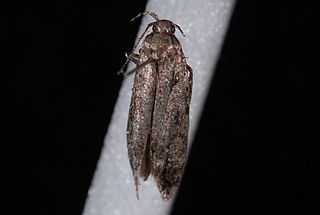
Curetis bulis, the bright sunbeam, is a species of butterfly belonging to the lycaenid family. It is found in Asia.
Agathactis is a genus of moths in the family Gelechiidae. It contains the species Agathactis toxocosma, which is found in Guyana.
Oestomorpha is a genus of moth in the family Gelechiidae. It contains only one species, Oestomorpha alloea, which is found in Mexico.
Helcystogramma gradatum is a moth in the family Gelechiidae. It was described by Edward Meyrick in 1910. It is known from north-eastern India.
Ardozyga plinthactis is a species of moth in the family Gelechiidae. It was described by Edward Meyrick in 1904. It is found in Australia, where it has been recorded from New South Wales.

Neotelphusa praefixa is a moth of the family Gelechiidae. It is found in North America, where it has been recorded from Alberta, British Columbia, Maine, Manitoba, Montana, Ontario, Quebec and Saskatchewan.
Recurvaria flagellifer is a moth of the family Gelechiidae. It is found in Mexico (Guerrero).
Telphusa ripula is a moth of the family Gelechiidae. It is found in Guatemala.
Scrobipalpa sibila is a moth in the family Gelechiidae. It was described by Edward Meyrick in 1921. It is found in Mozambique.
Untomia alticolens is a moth of the family Gelechiidae. It was described by Walsingham in 1911. It is found in Mexico (Guerrero).
Anacampsis primigenia is a moth of the family Gelechiidae. It was described by Edward Meyrick in 1918. It is found in Ecuador, Colombia and on the Galapagos Islands.
Aristotelia squamigera is a moth of the family Gelechiidae. It was described by Walsingham in 1909. It is found in Mexico (Guerrero).
Ptocheuusa asterisci is a moth of the family Gelechiidae. It was described by Walsingham in 1903. It is found in Spain.
Antiochtha vigilax is a moth in the family Lecithoceridae. It was described by Edward Meyrick in 1910. It is found in Sri Lanka.
Bassarodes is a monotypic moth genus in the family Xyloryctidae. Its only species, Bassarodes siriaca, is found on the Solomon Islands. Both the genus and species were first described by Edward Meyrick in 1910.
Eupragia solida is a moth in the family Depressariidae. It was described by Walsingham in 1911. It is found in Mexico, where it has been recorded from Tabasco.
Athrinacia leucographa is a moth in the family Depressariidae. It was described by Lord Walsingham in 1911. It is found in Mexico, where it has been recorded from Guerrero.
Antaeotricha discolor is a moth in the family Depressariidae. It was described by Lord Walsingham in 1912. It is found in Mexico (Guerrero) and Guatemala.
Stenoma symmicta is a moth in the family Depressariidae. It was described by Lord Walsingham in 1913. It is found in Panama and Guyana.
Stenoma epicta is a moth in the family Depressariidae. It was described by Lord Walsingham in 1912. It is found in Tabasco, Mexico.

